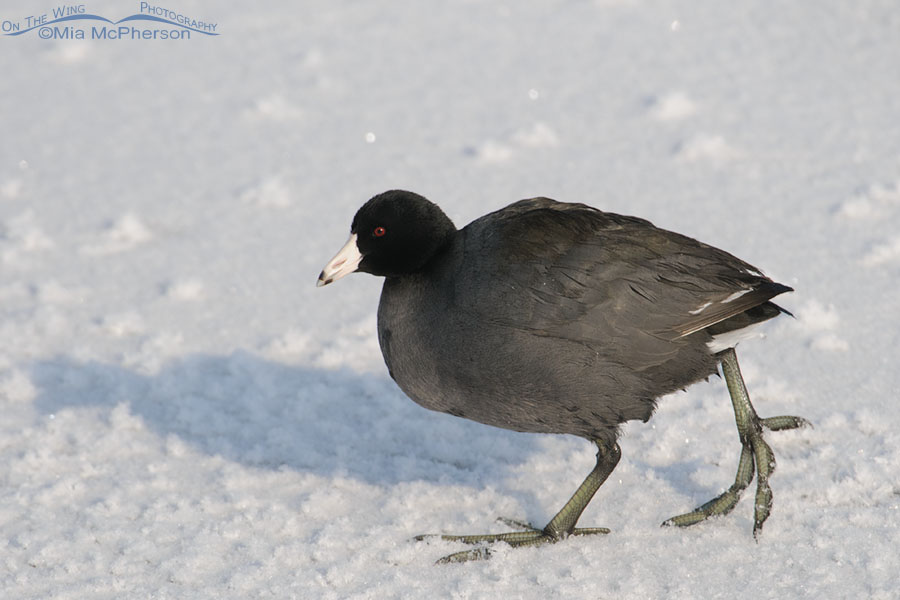I thought it might be fun for all of you to try and identify the bird species that match the feet in the image below. What we can see are greenish, lobed feet and a dark, rounded body. With just those two identification features can you guess which bird these feet belong to?
By the way, this species is abundant and is found throughout North America, Mexico and the Caribbean and it was photographed last week in Utah.
Throughout the year there are times when I spot birds that I only see parts of them and that is all I have to identify which species I am looking at. Sometimes that means I only see their head, their back, their tail, or their feet because something maybe be obstructing my view. That could be foliage, branches, flowers, a tree trunk, rocks, water or a combination of items. As an indirect result of that and the fact that I am usually being asked “What is it?” I have learned to identify birds at times using just one or two ID features.
Once you have decided what you think the bird species is pull on the white square on the right hand side of the image to reveal a photo that shows the bird.


Did you guess that the feet belonged to an American Coot? That is great if you did because that is the bird species the feet belong to! I’m sure most of you got the ID right away but people from all over the globe view my blog and what is a common bird for us isn’t for them.
American Coots prefer habitats near ponds, lakes, and marshes and during the winter they can also be found on coastal inlets and bays. Their odd looking, greenish, lobed feet make it easy for them to get around on land and in the water.
These coots are often mistaken for ducks because they mix in with waterfowl but they are actually members of the rail family.
The photo of the American Coot walking in the snow was taken at Farmington Bay WMA during the winter of 2013.

Adult American Coot on patrol close up
I adore coots for their feisty attitudes and the high contrast between their dark plumage and their ivory white bills is challenging. I don’t often willingly pass up on a chance to photograph them.
Life is good.
Mia
Click here to see more of my American Coot photos plus facts and information about this species.


Well, I have to admit my limited ornithological knowledge bubbled to the surface here. Other than suspecting waterfowl… I had no idea the feet belonged to a coot. I loved this post! Thanks Mia.
Fun quiz!
As soon as you said lobed feet…that is what I thought of. It is good to discover birds that we aren’t normally familiar with, so good for you. Covid is boring so I am up for a game or two. that is a lovely shot in the snow, not something I have seen before. Nice sharp focus on the feathers and the intense gaze in the last photo.
As they say, it takes one to know one, so I immediately guessed “coot!” Wonderful shots of another favorite and a high degree-of-difficulty bird, with respect to getting good detail.
Wonderful shots of another favorite and a high degree-of-difficulty bird, with respect to getting good detail.
Your title pulled me right in. Loved the idea! For some reason I guessed before visiting that the feet might belong to a coot, as they are such a unique and interesting adaptation to both terrestial and aquatic propulsion.
Years ago we had an imprinted coot at rehab, named simply Coot Coot. He loved being held and having his ears rubbed. He came in as a teenager raised by a family who had him for months. The kids had played with him and he was imprinted. Unless he got into trouble he wandered around rehab while we worked. Coots feet have the neatest feel. They are cool and supple. I have favorite birds, often the reasoning is due to ones I have interacted with at rehab. Coot Coot left a wonderful impression on his kind in my heart. By the way he was placed at Tracy Aviary.
Coot… Coot
I love their feet.
I don’t know how many times I’ve just taken pictures of their feet when they come out of the water or scratch their heads.
Children are fascinated and I’ve found that it was a way to get them interested in bird ID.
Thanks for all the wonderful photos
You are right.
Not at all common for me – and I failed.
Loved the detail in the shot. Thank you.